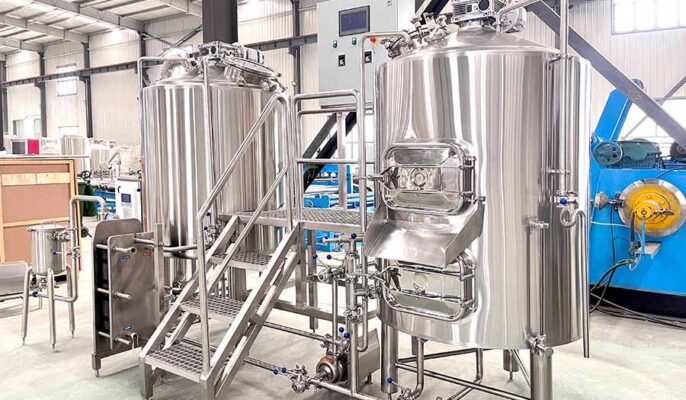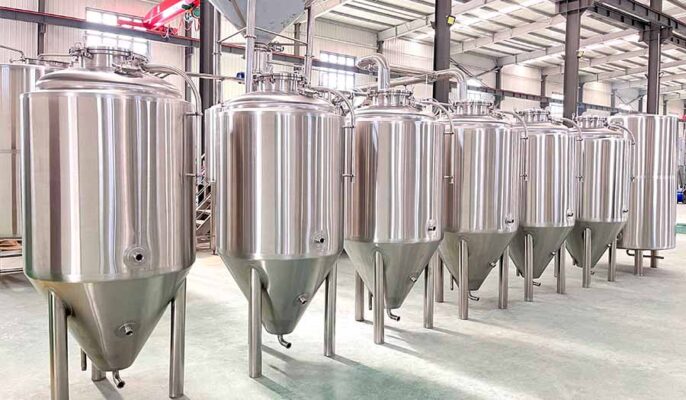Um sistema de microcervejaria é um equipamento especializado em fabricação de cerveja projetado para produzir pequenos lotes de cerveja, normalmente variando de alguns galões a centenas de galões. É frequentemente usado por cervejarias artesanais, cervejarias caseiras e pequenas cervejarias comerciais que valorizam qualidade, criatividade e flexibilidade em seu processo de fabricação de cerveja.
Definição do sistema de microcervejaria
Um sistema de microcervejaria é uma configuração de equipamento de fabrico de cerveja especializado, concebido para produzir pequenos lotes de cerveja, desde alguns galões até centenas de galões. É utilizado por cervejeiras artesanais, cervejeiras caseiras e pequenas cervejeiras comerciais que valorizam a qualidade, a criatividade e a flexibilidade no seu processo de fabrico de cerveja. Os sistemas de microcervejaria podem ser manuais ou semi-automáticos e são concebidos para acomodar uma variedade de estilos de cerveja e técnicas de fabrico de cerveja. Os sistemas de microcervejaria variam em tamanho e complexidade, mas todos eles se concentram na produção de cervejas únicas e de alta qualidade em pequenos lotes.
Componentes essenciais de equipamento de microcervejaria
Os sistemas de microcervejaria de alto desempenho são constituídos por vários componentes importantes, cada um dos quais desempenha um papel fundamental no processo de fabrico de cerveja. Aqui estão alguns dos principais componentes de um sistema típico de microcervejaria:
- Tina de brassagem e caldeira: A tina de brassagem é onde começa o processo de fabrico da cerveja, onde os grãos e a água quente são triturados para produzir um líquido açucarado chamado mosto. A caldeira é o local onde o mosto é fervido, onde se adiciona o lúpulo e outros ingredientes e onde se desenvolvem os sabores e aromas.
- Recipiente de fermentação: Após a ebulição, o mosto é arrefecido e transferido para um recipiente de fermentação, onde é adicionada levedura para converter o açúcar em álcool e dióxido de carbono. Os recipientes de fermentação podem ser feitos de aço inoxidável, plástico ou vidro e existem numa variedade de formas e tamanhos.
- Sistema de arrefecimento: O sistema de arrefecimento é utilizado para arrefecer o mosto fervido para evitar odores e assegurar a fermentação normal da levedura. Isto pode ser conseguido utilizando uma variedade de métodos, incluindo permutadores de calor ou sistemas de arrefecimento com glicol.
- Bombas e mangueiras: As bombas e as mangueiras são utilizadas para transferir o mosto e a cerveja entre os diferentes componentes do sistema de fabrico de cerveja, tais como as caldeiras e os recipientes de fermentação.
- Sistema de oxigenação do mosto: O oxigénio é necessário para o crescimento da levedura e para a fermentação. O sistema de oxigenação do mosto é utilizado para garantir que a levedura tem oxigénio suficiente durante o processo de fermentação.
- Sistema de controlo: O sistema de controlo é utilizado para observar e regular a temperatura, a pressão e outras variáveis durante o processo de fabrico da cerveja, para garantir a consistência da qualidade e do sabor da cerveja.
Estes são alguns dos componentes importantes de um sistema de microcervejaria de alto desempenho. Os componentes e configurações específicos podem variar consoante a preferência, o orçamento e os objectivos do fabricante de cerveja.

O desenvolvimento dos sistemas de microcervejaria
A história dos sistemas de microcervejaria remonta ao início dos anos 80, quando alguns cervejeiros pioneiros nos Estados Unidos começaram a fazer experiências com pequeno equipamento de fabrico de cerveja para produzir cervejas artesanais com sabores e estilos únicos. Estas primeiras microcervejeiras enfrentaram desafios significativos, incluindo elevados custos de arranque, disponibilidade limitada de ingredientes e equipamento de qualidade e uma falta de sensibilização dos consumidores e de procura de cerveja artesanal.
Apesar destes obstáculos, o movimento microcervejeiro cresceu nos anos 80 e 90, impulsionado pela paixão e dedicação de uma pequena mas crescente comunidade de entusiastas da cerveja artesanal. À medida que os gostos e preferências dos consumidores mudam para produtos artesanais de alta qualidade e de origem, as microcervejeiras começam a ganhar maior reconhecimento e aceitação.
Processo de fabrico de cerveja em microcervejarias
Sistema de trituração de malte
O malte é esmagado para dissolver melhor as substâncias contidas no malte. O malte é partido, mas não quebrado, e as cascas actuam como um filtro para a filtragem do mosto. O sistema de trituração é composto por um triturador de malte, um armazém de malte e um equipamento de alimentação. Os pequenos equipamentos só podem ser equipados com trituradores de malte.
Sistema de cervejaria
O sistema de brassagem é o núcleo de todo o equipamento de fabrico de cerveja e trata do processo de transformação do malte em mosto. Existem quatro etapas principais do processo: "mosto, filtração, ebulição e precipitação". Estas quatro etapas funcionais são completadas por vários tanques, o que se designa por "trituração em vários tanques". Uma caldeira de água quente é um equipamento auxiliar.
Os principais tipos de sistemas de brassagem para equipamentos de cerveja de pequena e média dimensão são:
- Dois conjuntos de equipamento para a sala de brassagem (tanque de filtragem do mosto + caldeira de decantação com vórtice de ebulição);
- Dois e três tanques da sala de brassagem (tanque de filtragem da sala de brassagem - tanque de sedimentação vortex + caldeira de ebulição);
- Dois dispositivos (tanque de filtragem da sala de brassagem + pote de sedimentação do vórtice de ebulição) + pote de água quente;
- Três equipamentos de produção de cerveja (caldeira de trituração + tanque de filtragem + caldeira de decantação com vórtice de ebulição) + caldeira de água quente;
- Quatro conjuntos de equipamento para mosto (pote de mosto + tanque de filtragem + pote de ebulição + tanque de decantação vortex) + pote de água quente.
Ao optar por comprar equipamento para cerveja, determine o tipo, a configuração e a escala do equipamento de sacarificação utilizado com base nas condições do local, nos requisitos do processo de fabrico de cerveja e nos requisitos do lote de produção. Além disso, considere os custos de investimento.
Fermentador
A importância de um fermentador reside na sua capacidade de controlar a temperatura e a pressão durante a fermentação da cerveja. Isto afecta o produto final, uma vez que a temperatura e a pressão afectam o sabor, o aroma e o teor alcoólico da cerveja. Os fermentadores também ajudam a evitar a contaminação e garantem uma fermentação consistente em todo o lote.
Existem muitos tipos de fermentadores, incluindo fermentadores abertos, fermentadores fechados e fermentadores cónicos. Os fermentadores abertos são menos comuns porque são mais susceptíveis à contaminação, mas alguns fabricantes de cerveja preferem-nos porque podem produzir sabores mais complexos.
Tanque de regulação
Quando a cerveja tiver completado o processo de fermentação, pode ser transferida para um tanque de condicionamento. Este tanque permite que a cerveja envelheça e amadureça, o que pode afetar o sabor final e a qualidade da cerveja. O processo de condicionamento é crucial porque ajuda a criar uma cerveja mais suave, mais refinada e com um melhor sabor.
Existem muitos tipos de tanques de condicionamento, incluindo tanques horizontais, tanques verticais e tanques brilhantes. As cisternas horizontais são ideais para as grandes cervejeiras porque podem conter grandes quantidades de cerveja e são fáceis de limpar. As cisternas verticais são mais utilizadas em pequenas cervejeiras porque ocupam menos espaço e são mais fáceis de deslocar. Os tanques brilhantes são utilizados para carbonatação e clarificação e são herméticos para evitar a oxidação.

A diferença entre um sistema de microcervejeira e um sistema de cervejeira tradicional
- Tamanho do lote e capacidade de produção: Os sistemas de microcervejaria produzem pequenos lotes de cerveja, que variam entre alguns galões e centenas de galões, enquanto os sistemas de cervejaria tradicionais são concebidos para produzir grandes quantidades de cerveja, muitas vezes mais de 1.000 galões por lote.
- Nível de automatização: Os sistemas de microcervejaria podem ser manuais ou semi-automáticos, dando aos fabricantes de cerveja um maior controlo sobre o processo de fabrico e a capacidade de fazer ajustes no processo, enquanto os sistemas de fabrico de cerveja tradicionais são automatizados, com pouca margem para personalização ou alteração.
- Flexibilidade no desenvolvimento de receitas: Os sistemas de microcervejaria proporcionam uma maior flexibilidade no desenvolvimento de receitas, permitindo aos fabricantes de cerveja experimentar diferentes ingredientes, técnicas de fabrico e estilos de cerveja, enquanto os sistemas de fabrico de cerveja tradicionais necessitam de uma maior flexibilidade no desenvolvimento de receitas devido à necessidade de se manterem consistentes. Os grandes lotes tendem a ser mais limitados em termos de qualidade e sabor.
- Qualidade e consistência da cerveja: Embora tanto os sistemas de microcervejaria como os tradicionais possam produzir cerveja de alta qualidade, os sistemas de microcervejaria permitem um maior controlo sobre o processo de fabrico da cerveja, resultando numa maior consistência e qualidade do produto final.
Método de aquecimento do equipamento de microcervejeira
Elétrico
Recomendamos o aquecimento elétrico para fábricas de cerveja até 840L/7BBL, uma vez que para além deste tamanho começará a consumir muita eletricidade. Seria melhor considerar outras opções, mas teremos todo o gosto em expandir para uma fábrica de cerveja e HLT maiores, de acordo com as suas necessidades.
Fogo direto
Recomendamos o aquecimento por combustão direta para cervejeiras com mais de 600L/5BBL, uma vez que este proporciona uma área suficiente para que a câmara de combustão por baixo do recipiente funcione.
Vapor
Recomendamos esta opção para fábricas de cerveja de todas as dimensões, se conseguir encaixar o custo no orçamento e no espaço para o equipamento. Obtém-se uma eficiência de aquecimento óptima e a possibilidade de utilizar o vapor noutras áreas da fábrica de cerveja.
Que tipo de equipamento de microcervejaria pretende?
Quanto mais elevado for o grau de automatização, mais fácil será fabricar produtos normalizados. Ajuda a engrossar a cerveja. Ter a capacidade de fabricar uma cerveja que pode ser replicada vezes sem conta cria confiança junto dos seus clientes. É claro que a automatização tem custos mais elevados e, se o seu orçamento for apertado, analise as áreas em que a automatização seria mais benéfica para si e coloque-a em prática sempre que possível. Claro que também pode contactar a micet, e os nossos engenheiros desenvolverão um plano de microcervejaria que seja mais adequado para si, com base na sua situação.




